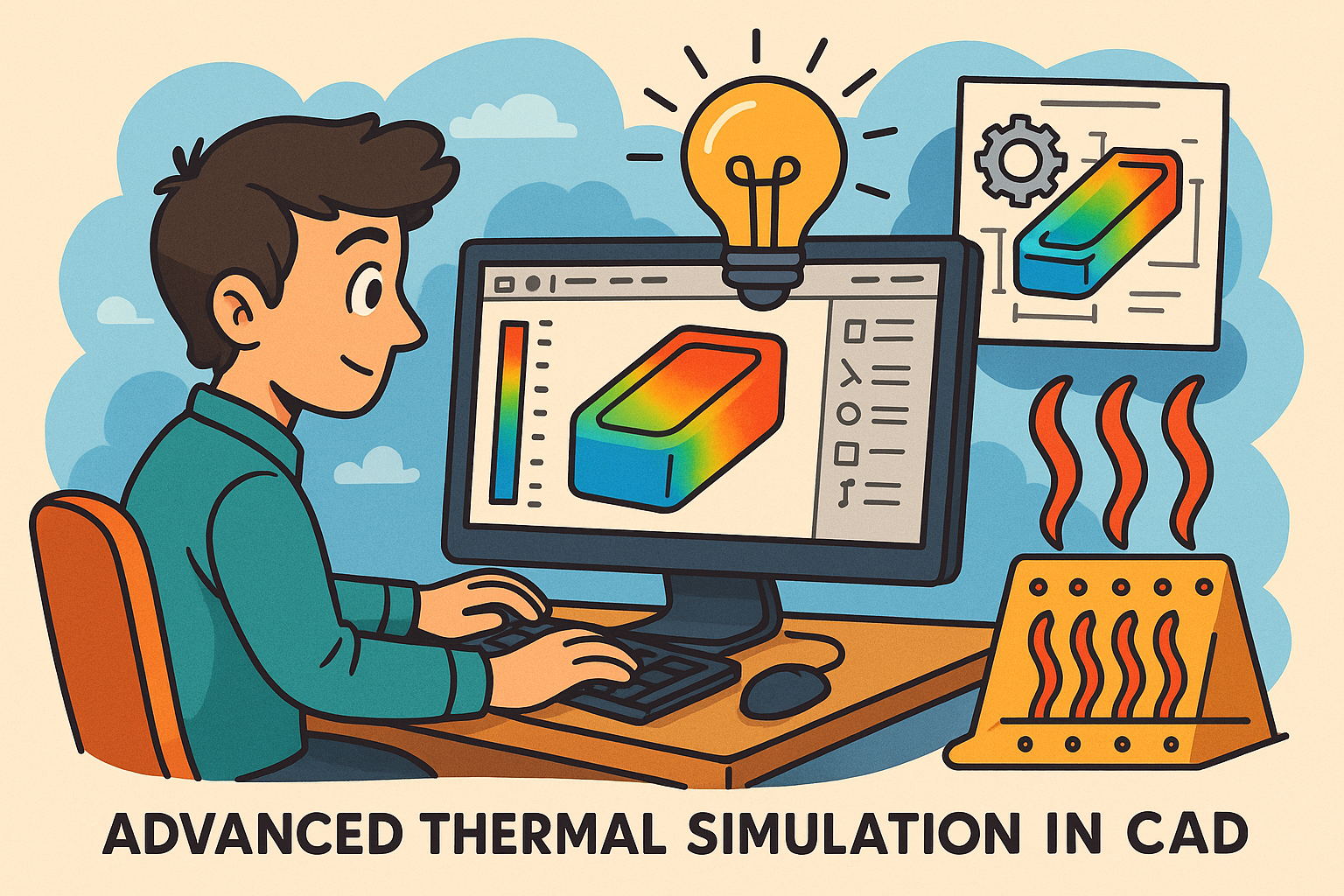Your Cart is Empty
Customer Testimonials
-
"Great customer service. The folks at Novedge were super helpful in navigating a somewhat complicated order including software upgrades and serial numbers in various stages of inactivity. They were friendly and helpful throughout the process.."
Ruben Ruckmark
"Quick & very helpful. We have been using Novedge for years and are very happy with their quick service when we need to make a purchase and excellent support resolving any issues."
Will Woodson
"Scott is the best. He reminds me about subscriptions dates, guides me in the correct direction for updates. He always responds promptly to me. He is literally the reason I continue to work with Novedge and will do so in the future."
Edward Mchugh
"Calvin Lok is “the man”. After my purchase of Sketchup 2021, he called me and provided step-by-step instructions to ease me through difficulties I was having with the setup of my new software."
Mike Borzage
Advanced Thermal Simulation in CAD: Transforming Design and Engineering
June 16, 2025 10 min read


Introduction to Thermal Simulation in CAD Software
Overview and Significance
Thermal simulation is a cornerstone technology that has profoundly transformed the way engineers approach design challenges by replicating and analyzing heat transfer phenomena in virtual environments. In today’s competitive engineering landscape, the ability to accurately predict temperature distributions, identify thermal bottlenecks, and model real-world heat dissipation is paramount. **Thermal simulation** plays a critical role in myriad engineering processes; it informs decisions related to material selection, component layout, and system integration by providing insights that are essential for enhancing performance and ensuring reliability. Over the past several decades, designers have witnessed a dramatic shift in the fidelity and complexity of these analyses as computational methods have advanced. From the initial rudimentary techniques that relied on simplified mathematical approximations to the sophisticated full-scale numerical methods available today, the evolution in thermal simulation has kept pace with the rapid expansion of CAD software capabilities.
Early implementations of thermal analysis required significant manual intervention and were often constrained by limited computational resources, but modern CAD packages now integrate seamlessly with thermal solvers, thereby eliminating many traditional barriers. The convergence of simulation and design not only accelerates the development cycle but also enhances the reliability of the final product. This integration is highly valued by professionals who demand high fidelity in thermal predictions and appreciate the automation that modern systems offer. The design community now embraces this technology due to its ability to predict critical performance issues before prototypes are manufactured, effectively reducing cycle times and overall costs. In summary, the emphasis on **engineering processes** that combine thermal analysis with traditional design practices has revolutionized product development, setting new standards for innovation and efficiency.
Evolution and Current Demands
The evolution of thermal simulation within CAD software has been driven by the increasing complexity of modern designs and the need for greater accuracy in the prediction of thermal behaviors. Initially, design software offered only basic thermal analysis, but as computational power expanded, simulation tools became capable of handling non-linear phenomena, transient effects, and multi-dimensional interactions. The transformation has resulted in powerful simulation engines that integrate seamlessly with CAD environments. Today, design engineers expect simulation tools that not only deliver robust analysis but also incorporate features that allow for *fluid-thermal interactions* and coupling with other physical domains. This increased capability provides a more realistic representation of the working conditions components may face during operation.
Several factors are fueling the current demand for high-fidelity thermal simulation tools:
- Enhanced Product Complexity: Modern engineering systems combine electronic, mechanical, and thermal processes that require integrated analysis for optimal performance.
- Growing Regulatory Pressure: Stricter standards around safety and environmental impact necessitate precise thermal modelling to ensure conformity.
- Rapid Prototyping Needs: The drive for faster prototyping and reduced time-to-market demands reliable simulation data early in the design phase.
Exploring Advanced Thermal Simulation Features
State-of-the-Art Capabilities
The realm of thermal simulation in design software has expanded notably with the advent of state-of-the-art capabilities that address the most challenging thermal issues in modern engineering. Contemporary systems can simulate **non-linear heat transfer** phenomena, where traditional linear approximations fail to capture the dynamic behavior of heat propagation in complex materials. In addition, current CAD-integrated solvers now facilitate the simulation of *fluid-thermal interactions*, a feature crucial for systems where coolant flow or air convection plays a significant role in dissipating heat. When these capabilities are combined with multi-physics coupling, it empowers engineers to predict not only heat transfer but also how thermal phenomena interlink with mechanical stresses and electromagnetic fields.
To illustrate, designers are able to model scenarios where a surge in temperature modifies the surrounding material properties, which in turn affects the fluid flow dynamics. Such synergistic effects, while challenging to predict with older methods, are now accessible through integrated algorithms in modern CAD environments. Key features spanning these capabilities include:
- Adaptive Mesh Refinement: Dynamically adjusts mesh density based on thermal gradients to ensure the precision of simulation results.
- Transient Thermal Analysis: Evaluates temperature changes over time, crucial for understanding start-up and shutdown sequences of machinery.
- Coupled Multi-physics Solvers: Simultaneously consider thermal, mechanical, and fluid dynamics, leading to a holistic simulation of operational conditions.
Modeling Accuracy and Computational Efficiency
Underpinning the effectiveness of modern thermal simulation tools is the dual focus on modeling accuracy and computational efficiency. CAD software developers have invested heavily in advanced numerical methods that are capable of resolving heat transfer nuances with exceptional precision, even in situations that involve complex boundary conditions or non-homogeneous materials. For instance, simulations now incorporate refined spatial discretization and multi-step time integration schemes that more accurately capture thermal gradients, particularly in regions where temperature variations are rapid. Furthermore, these simulations are executed with optimized algorithms that intelligently distribute computational resources, ensuring that even simulations on large-scale assemblies remain tractable.
The drive for computational efficiency is particularly crucial as simulation tasks become more resource-intensive. In response, new methodologies have been put forward that reduce the computational cost without compromising on the quality of results. This includes:
- Parallel Processing Techniques: Leveraging multi-core processing and cloud computing infrastructure to accelerate simulation runtimes.
- Adaptive Mesh Strategies: Automatically refining and coarsening the mesh in critical areas to maintain high precision where needed while conserving computational resources elsewhere.
- Algorithmic Simplifications: Utilizing novel approximation methods that bypass unnecessary calculations while still delivering scientifically sound results.
Innovative Algorithms and Integrations
The integration of innovative algorithms within thermal simulation software marks an outstanding leap forward in engineering analysis. In modern CAD environments, dedicated simulation modules incorporate artificial intelligence and machine learning techniques to predict thermal behaviors based on historical data and iterative feedback. These algorithms dynamically learn and adapt during simulation runs, effectively refining their predictive capabilities as the simulation progresses. The incorporation of such state-of-the-art methodologies enhances the overall precision of the simulation outputs. Moreover, software integrations have made it possible to incorporate simulation data directly into the design decision process, where engineers adjust parameters on the fly based on real-time thermal feedback.
Several key developments underscoring these innovative approaches include the utilization of:
- Predictive Modeling: Algorithms that forecast thermal behavior trends even under fluctuating operating conditions.
- Integrated Data Feedback Loops: Systems that continuously update simulation models based on emerging data streams, ensuring synchronization with evolving design parameters.
- Cross-Platform Compatibility: Seamless communication between simulation modules and CAD platforms, which ensures that changes in geometry are automatically reflected in thermal analyses.
Integration and Practical Applications
Best Practices for Workflow Integration
Successfully integrating advanced thermal simulation capabilities into existing CAD workflows requires careful planning and a strong emphasis on best practices. The design process benefits considerably when simulation data is not treated as an isolated step but rather as an integral part of the overall development lifecycle. Engineers are encouraged to adopt software solutions that offer seamless connectivity between the design and simulation modules, thereby ensuring that any geometric modifications are immediately reflected in the thermal analysis. Adhering to standardized protocols not only fosters consistency across projects but also minimizes the risk of errors, particularly when handling complex multi-component assemblies. Embracing a culture of iterative validation is essential, as it ensures that thermal performance issues are caught early in the design process.
Among the strategies that have proven effective are:
- Standardized Data Formats: Utilizing common data protocols to ensure compatibility across simulation and CAD software.
- Modular Simulation Modules: Breaking down the simulation process into manageable components that can be updated independently.
- Continuous Feedback Mechanisms: Setting up systems to automatically check and validate design modifications through simulation outputs.
Industry Applications and Deployment
The application of advanced thermal simulation technologies extends across a wide spectrum of industries, each with its own set of unique challenges and requirements. In engineering sectors such as aerospace, automotive, and electronics, heat management is critical to ensure reliability and performance under demanding operational conditions. For instance, aerospace engineers rely on thermal simulation to evaluate how heat affects composite materials in a high-altitude environment, while automotive engineers use similar tools to determine optimal coolant flow for engine components. In electronics, thermal simulation is essential for designing systems that can efficiently dissipate heat generated by densely packed circuitry. When these advanced simulation tools are properly integrated into existing CAD workflows, the design process becomes significantly more efficient and robust.
This efficient deployment of thermal simulation systems is made possible by a combination of robust software infrastructures and a commitment to systematic validation methods. The following elements are vital for a successful application in industry:
- Robust Integration Frameworks: Ensuring that simulation modules communicate effectively with the CAD system through well-defined interfaces.
- Scalable Cloud Computation: Utilizing distributed computing power to handle complex simulation tasks involving transient thermal conditions.
- User-Centric Training Programs: Investing in training initiatives to equip engineering teams with the necessary skills to interpret simulation results accurately.
Challenges and Strategies for Overcoming Hurdles
Despite the numerous benefits of incorporating advanced thermal simulation into CAD workflows, several challenges persist that demand careful attention. One of the primary hurdles faced by engineering teams is ensuring that the simulation data remains consistent with the constantly evolving design geometry. As products are refined and iterated upon, maintaining data compatibility requires efficient version control as well as comprehensive user training. In addition to data synchronization issues, there are challenges associated with the inherent complexity of modern thermal phenomena. Simulating coupled multi-physics systems—where thermal, mechanical, and fluid dynamics interact—can produce high computational loads, which may impede timely decision-making. Furthermore, engineers must contend with the need to validate simulation outputs against experimental results, a task that is both time consuming and resource intensive.
Several strategies have emerged to address these challenges effectively. Key approaches include:
- Robust Version Control Systems: Ensuring that every design iteration is accurately tracked and compatible with simulation datasets.
- Modular and Configurable Simulation Protocols: Leveraging adaptable simulation workflows that can be tailored to project-specific requirements.
- Enhanced User Training Programs: Providing comprehensive educational resources to help engineers understand simulation nuances and troubleshoot issues effectively.
Conclusion
Recap and Future Outlook
In today’s rapidly evolving technological landscape, advanced thermal simulation capabilities in CAD software have emerged as indispensable tools for modern engineering. Throughout this discussion, we have examined how refined simulation modules integrating **non-linear heat transfer**, fluid-thermal interactions, and multi-physics coupling have moved thermal analysis from a peripheral consideration to a central element in the design process. The push for higher accuracy, computational efficiency, and seamless integration with existing CAD workflows has redefined industry standards for product development. By harnessing sophisticated algorithms and robust integration platforms, engineers are better equipped to predict thermal performance issues, optimize designs, and ensure overall product reliability. Looking forward, the trajectory of thermal simulation technology points towards even greater synthesis between simulation and design. The increasing adoption of predictive modeling, machine learning techniques, and adaptive resolution methods promises to push the boundaries of what is achievable in thermal analysis. As these innovations continue to mature, we can expect thermal simulation to remain at the forefront of engineering processes and to drive significant improvements in design quality as well as operational efficiency.
Future trends indicate that developments in cloud-based simulation, increased emphasis on real-time data analysis, and further reductions in computational overhead will collectively transform the way design engineers approach thermal management challenges. The industry is steadily converging on solutions that empower designers with real-time thermal insights, which in turn facilitate rapid prototyping and iterative design refinements. With emerging technologies continuing to bridge the gap between physical testing and digital simulation, the role of thermal simulation in the design process will only become more pronounced. Embracing these advancements will be essential for any organization aiming to maintain competitiveness in a market increasingly driven by the need for high-performance, reliable products.
Final Reflections on Advancements in Thermal Simulation
As we draw our analysis to a close, it is evident that the integration of advanced thermal simulation features within CAD software has redefined the parameters of modern engineering design. Today’s simulation tools not only enhance the precision of thermal predictions but also facilitate a more fluid and interactive design cycle, offering engineers an unprecedented level of control over the thermal performance of their products. Emphasizing best practices for workflow integration, leveraging state-of-the-art computational techniques, and adopting innovative algorithms has fostered an environment where complex thermal challenges can be addressed efficiently. The ability to simulate multi-physics interactions and adapt to evolving design geometries has significantly increased the reliability and overall performance of engineered products, paving the way for breakthroughs across various technical disciplines.
In conclusion, the strategic deployment of advanced thermal simulation in CAD systems is no longer optional; it is a critical component of any forward-thinking engineering process. As technology continues to evolve, we anticipate that future software iterations will further integrate thermal analysis into everyday design tasks, transforming the way engineers approach problem-solving and product realization. These advancements not only underscore the importance of simulation within design workflows but also highlight the continuous commitment of engineers to innovate and improve product quality, functionality, and safety.
Also in Design News
Subscribe
Sign up to get the latest on sales, new releases and more …





